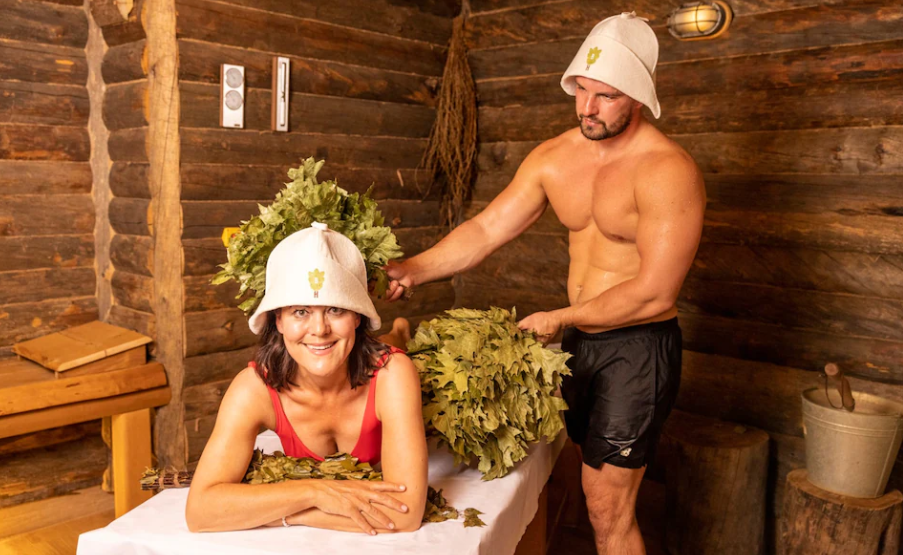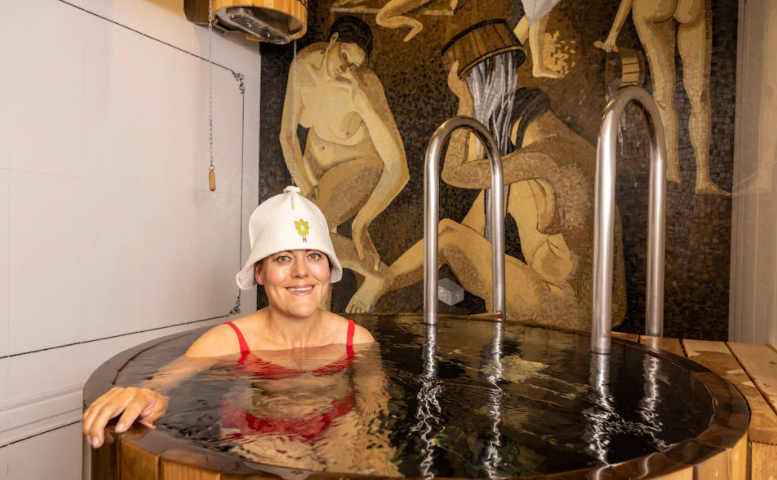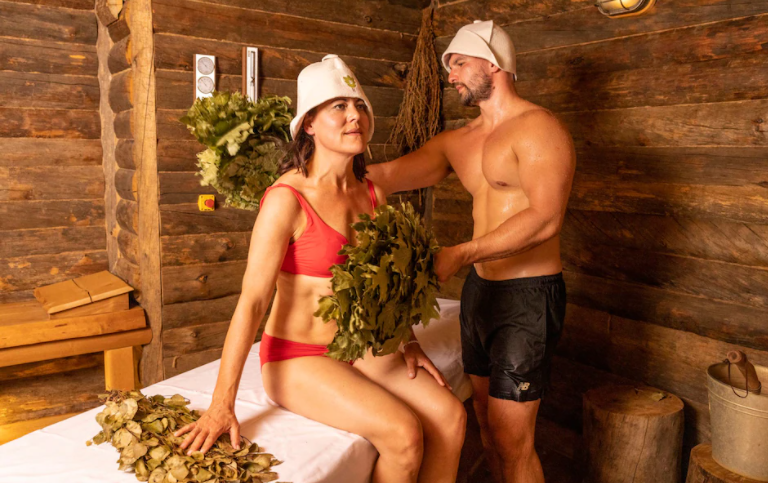

Hot baths and saunas can mimic many of the health benefits of exercise CREDIT: Heathcliff O’Malley

Humidity, ice buckets, birch branches, felt hats and vodka – this ancient Russian ritual is growing in popularity in the UK
Like many midlife menopausal women, I became addicted to wild swimming before lockdown. Cold water immersion cured my hot flushes and calmed my over-revved mind. Post lockdown, I have graduated to a new wellness obsession currently gaining momentum in Britain; I now crave the health-high experience of a traditional Russian banya.
The Russians refer to the banya as “the people’s first doctor”, while William Tooke, an English doctor, wrote in 1779 that: “Quite often Russians use banya instead of medicine. And there is no doubt that this is a key to their great health and long lives.”
This ancient Russian tradition of warming the body via steam from a wood fire, then a bracing Baltic-cold ice bucket tipped over your head, renders one rag-doll relaxed yet mentally alert. It offers the euphoria of wild swimming, yet the heat – with temperatures of 60 to 80 degrees C and humidity of 70 per cent – alleviates joint and muscular pain too.
The banya experience is now being offered at British spas, just as the benefits of heat therapy are being borne out in evidence. In May, researchers at Coventry University published a study showing hot baths and saunas can mimic many of the health benefits of exercise – improving fitness levels, lowering blood pressure and inflammation and improving blood sugar control.
What makes a banya different from a sauna is the birching (parenie). This is when bunches of eucalyptus, oak and birch leaves, known as venik, (cut at optimum times and stored for over a year) are used by banya masters to drive the heat around your torso.
This penetrating heat is said to help remove lactic acid, salt and urea from the body, while facilitating the absorption of oxygen – which is why athletes use the banya to promote recovery from injury. You wear a funny felt hat to prevent your fontanelle from over-heating, and cold eucalyptus leaves cool your face. I find it calms the central nervous system, so after a session my sleep is immeasurably improved (It should be mandatory for anyone with insomnia).
The whole process is elemental, communal, ritualistic and ends, if you want, with a vodka, beer or bowl of borscht. Authentic banyas have space for socialising, eating and drinking.
The banya has a rich cultural history. Before the arrival of Christianity, it was the spiritual centre of Russian community. People gathered at these baths not only to wash, but to worship, mourn, marry, feast and to bid farewell. Women often gave birth in the banya and the dead would be bathed and sent on their way to the afterlife.
While people no longer give birth or die in the banya, it remains an essential part of Russian life. Putin is a regular banya visitor, which, according to a Russian friend, means that “he is a strong man who takes Russian tradition seriously”.
Ethan Pollock, author of Without The Banya We Would Perish (the title is a famous Russian idiom), writes: “Russians went to the banya long before they understood it in modern medical terms. Russians understood that, unlike a shower or a bath, going to the banya could transform a person in spiritual as well as physical ways.” A Russian girlfriend of mine says: “It’s a wellness marvel, if done properly.”
According to Sophie Benge, East European wellness expert and author of Healing Sources: Spa and Wellbeing from the Baltic to the Black Sea: “The banya is like a mind, body, spirit MOT. While there are 30 types of steam bath in the world, the banya is my favourite. It’s incredibly physical; almost like a training for the cardiovascular system because of the mechanical dilation of the blood vessels.
Hot and cold therapy is so simple yet hugely underestimated in terms of a health kick.” Benge also praises the benefits of the venik.
“People assume the birching is like being thrashed,” she says. “But the light tapping works on the lymph system. This is an under recognised part of our body but when the lymph clogs up, we get disease, as it is the drainage system of the body. It also feels like the subtle energy systems of the body are cleared, as they are wafted with medicinal herbs. There is a ritualistic element to the banya which is especially soothing.”
As well as the physical benefits to the cardiovascular, respiratory and musculoskeletal systems, most relevant in our Covid-19 world are the banya’s advantages to the lungs and immune system, with some studies showing it can combat colds and viruses and improve conditions such as asthma.
But Russians also come for spiritual reasons – silence, reflection, the connection with nature (fire, water, wood and herbs encapsulate banya) – along with the chance to socialise and chat, bringing benefits for brain health and mental wellbeing.
“People either come with friends, and this nurtures connection, or they find it, as I do, a meditative space, so they come to switch off and mentally reset.” says Robert Procopé, co-owner of The Bath House, the latest banya to open in central London.
According to Procopé, 65 per cent of the clientele at The Bath House is British. As well as two banyas in London, with a third about to open, there is Beach Box in Brighton – three saunas on the beach, which includes a banya – while pop-up banyas are emerging along the south coast. There is also Hot Box, which offers a similar experience on the banks of Loch Tay in Scotland.
Liz Watson, co-founder of Beach Box, which charges £30 per person for two hours, says: “The banya encompasses everything. It is sociable, it is a healthy way for people to get together and we are seeing increasing numbers of repeat visitors.
In our over-revved, over-addicted society, people are looking for a way to reconnect to nature and to themselves. Two hours in a banya never seems enough. I find that being in that heat makes my brain stop. People are getting addicted to the deep relaxation that banya offers.”
The first time I went to The Bath House, I felt as if my Russian soul had come home. There is a feeling of sanctuary; you don’t just drop in to a banya, you book your session ahead. The ritual of taking time out – at least two hours – is beneficial on every level. I aim to go once a week – the standard package is £95 for three hours, including a salt scrub.
I love the parenie, where a young Russian – a banschchik – guides you through the birching process. I’m not a fan of saunas, as I don’t enjoy feeling hot, but the way that they control the heat with the venik is genius as it never becomes unbearable.
Sergey Belyaev, a Russian banya master and blogger, who runs banya spa holidays throughout Russia, says he is seeing increasing numbers of British visitors drawn to what he sees as the tradition’s “magical, healing powers”.
“In Russia we have a proverb which says ‘on the day you go to banya, you don’t get older’.” I’ll raise a shot of vodka to that.